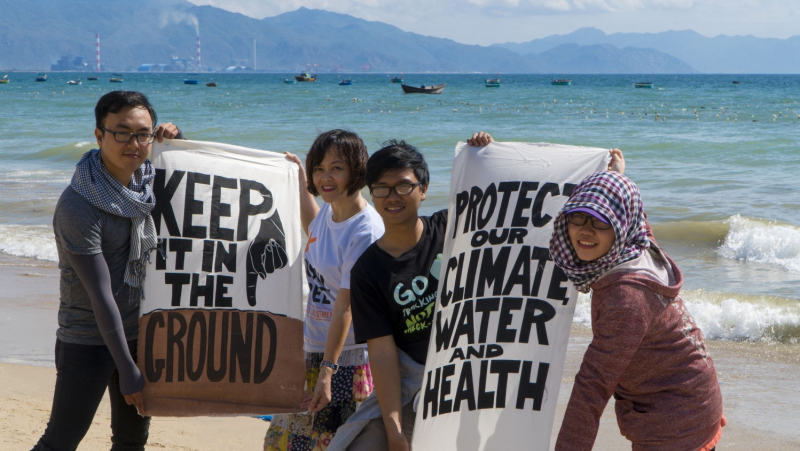Project – On record
This profile is no longer actively maintained, with the information now possibly out of date
Project – On record
This profile is no longer actively maintained, with the information now possibly out of dateWhy this profile?
The planned Vinh Tan III coal power plant will negatively impact local people and the environment. Local livelihoods and the population's health are already negatively affected by the existing power plants, and the situation would worsen with the construction of a new power plant. Vinh Tan III will also massively contribute to climate change by emitting over 11 million tonnes of CO2 each year.
What must happen
The Paris Climate Agreement goals require a managed decline of fossil fuel production, and the construction of new coal fired power plants is not compatible with this. Banks must therefore immediately stop financing new coal-fired power plant developments anywhere in the world.
| Sectors | Coal Electric Power Generation |
| Location |
|
| Status |
Planning
Design
Agreement
Construction
Operation
Closure
Decommission
|
|
|
This project has been identified as an Equator Project |
The Vình Tân III thermal coal power plant is part of a planned four unit power center in the Vình Tân, Bình Thuận province of Vietnam. lt will generate up to 12 billion kilowatt-hours annually, from three supercritical 660MW units which will be fueled with imported anthracite (hard coal). In 2008, the project's sponsor, OneEnergy, a joint-venture between CLP Group and Mitsubishi Corporation, signed a USD 1.1 billion contract with Electricity of Vietnam (EVN) to build the plant, beginning construction in 2010. Due to new Build, Operate and Transfer (BOT) regulations, the contract between the project sponsor and the government could not be signed until October 2015. The project is expected to cost USD 2 billion.
The energy centre at Vinh Tan consists of four units which are independent from each other, financially as well as operationally:
- Vinh Tan I: the construction of the two-unit 1,200MW power plant has reached completion. The first unit was commissioned in June 2018. The second unit has undergone successful test operations in January 2019;
- Vinh Tan II: both units of the supercritical 1,245MW plant have been online since 2014;
- Vinh Tan IV: both units of the fourth supercritical 1,200MW power plant are online. The first unit was completed in December 2017 and the second in October 2018;
- Vinh Tan IV Extension: in 2016, it was announced that the fourth complex would be extended for another 600MW unit. The plant conducted successful test operations in April 2019 and is scheduled to be commissioned in October 2019.
Social and human rights impacts
Local communities already suffer from ash and fumes that are blown into their neighbourhoods from the existing units of the Vinh Tan energy centre. Local people report that the ash penetrates living spaces, sets on surfaces and makes people cough. Restaurant owners complain that rice dishes turn black when put on the table. The loss of marine life also affects local fishermen, aquaculture and tourism.
In April 2015 local residents blocked the main highway for several hours to protest against the immense impacts on livelihoods and health due to pollution and the transportation of ash in uncovered lorries. Local authorities urged the operator to mitigate pollution and imposed a fine of around VND 1.5 billion (USD 69,510). Contrasting the protest and authorities' request to mitigate pollution, lorries were re-directed to smaller streets, the dumping sites were covered with canvas to prevent dispersion but dumping still continued and locals have reported that pollution got worse. Responsible for this increased pollution is Vinh Tan II which came into operations in 2014. Filters to absorb dangerous elements from the fumes are still not implemented sufficiently and pollution control is by officials of industrial zones generally considered too expensive.
Environmental and climate impacts
The Vinh Tan III project will be responsible for emitting over 11 million tonnes of CO2 each year. Coal for the plant will be imported via a deep sea port and there are concerns that the construction of the port, delivery of coal by large vessels, dumping of ash waste and the discharge of cooling water will endanger aquatic life. In addition the relocation of coral from the shore of Vinh Tan to the Hon Cau Marine Protected Area (MPA) off shore, disturbs the aquatic ecosystem and the diversity of marine life severely. The construction of Vinh Tan III will increase this threat to the marine ecosystem.
Waste disposal from the plant presents additional alarming impacts. Initially, waste from Vinh Tan II was stored in open pits, until locals protested and the pits were covered. In November 2016 the plant’s operator requested permission to dump 1.5 million cubic metres of industrial waste into the MPA, arguing that it was only "natural sediment", although this was challenged by scientists and the Hon Cau MPA itself.
Water intake (millions of cubic meter per year) for the entire Vinh Tan power centre is likely to harm marine lives such as fish, shrimp and crabs, fish eggs and larvae. The destruction is twofold: these marine lives can be trapped on the intake screen or sucked through plants’ heat exchanger.
HSBC is the financial advisor for the USD 2 billion project, with China Development Bank being the lead arranger of the financiers.
DBS dropped out of Vinh Tan III coal-fired bank syndicate in July 2017.
In December 2019, Standard Chartered withdrew its financial support for this Dodgy Deal. In 2018, Standard Chartered stated that it would no longer finance new coal-fired power plants anywhere in the world, unless a commitment was already made to a project. One of these projects was Vinh Tan III. In 2019 the bank confirmed it would withdraw from this project, thereby closing the loopholes in its 2018 policy.
In January 2020 HSBC announced its withdrawal from the Vinh Tan III coal power plant project (Ecobusiness.com).

